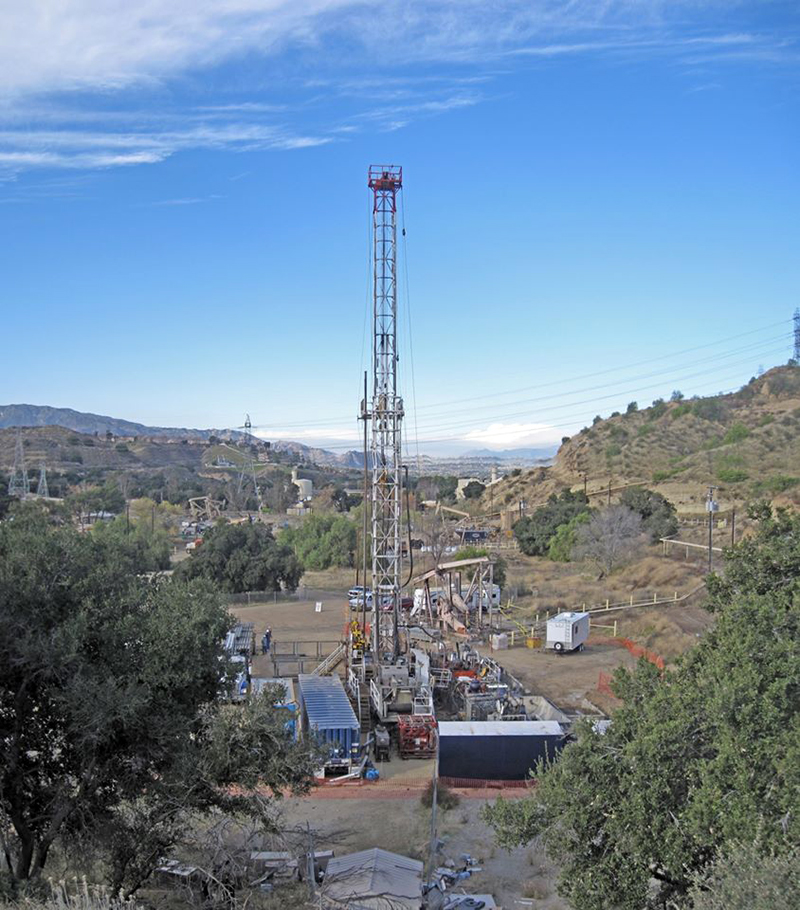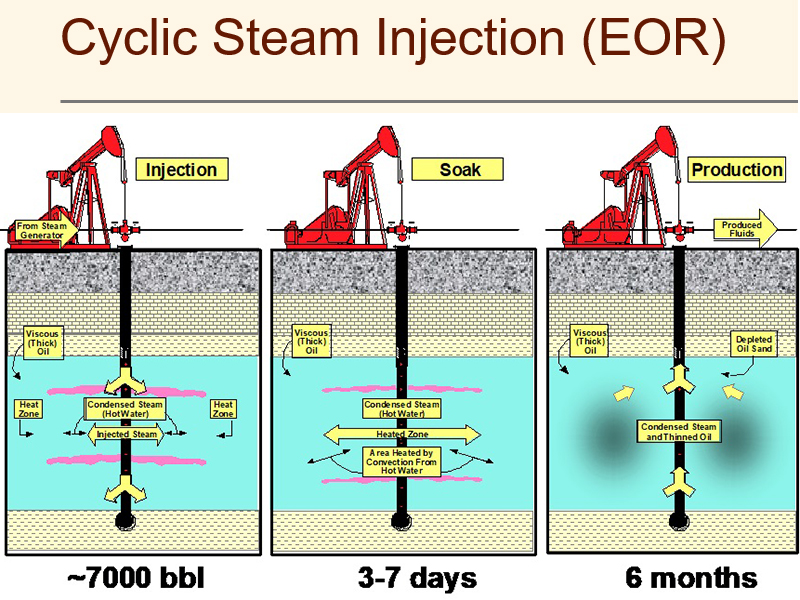Installation of New Oil Well
Placerita Oil Field | Newhall, California

December 22, 2019 — A new cyclic-steam oil well is being drilled and set up in the Placerita Oil Field — one month after the state of California issued a moratorium on "new extraction wells that use a high-pressure cyclic steaming process to break apart a geological formation to extract oil." The location is just west of Sierra Highway, north of Placerita Canyon Road. The well is No. 11-22X on the Highway lease. In its corporate filings, the oil field operator, Berry Petroleum Corporation, defines the Placerita Oil Field as a mature field with "recompletion" opportunities, recompletion being the deepening or horizontal extension of an existing wellbore into a new geological formation. In November, Berry's stock price plunged on the news of the moratorium. The company responded with a statement saying it had previously obtained permits that would enable it to "drill, produce and grow production using high-pressure cyclic steaming processes into 2020," and that "the overwhelming majority of Berry's cyclic steam operations does not require high-pressure cyclic steam injection." By late December, Berry shares had recovered most of their loss. The Placerita Oil Field has been under development since 1948. The current (2019) owner is Berry Petroleum, whose principal California resources are in Kern County/San Joaquin Valley. Berry purchased the Placerita field in 1999 from Aera Energy LLC, a venture of Shell and ExxonMobil.
November 19, 2019, DOGGR — The Department of Conservation's Division of Oil, Gas and Geothermal Resources ... today announced a series of initiatives to safeguard public health and the environment, advance California's goal to become carbon-neutral by 2045 and manage the decline of oil production and consumption in the state ... [including] A halt of approvals of new oil extraction wells that use high-pressure steam to break oil formations below the ground.
This moratorium prohibits new extraction wells that use a high-pressure cyclic steaming process to break apart a geological formation to extract oil. During the moratorium, regulators will consult with experts to examine records from recent leaks of oil and water, known as surface expressions, in the Cymric oil field in Kern County to determine whether high-pressure cyclic steaming can be done safely and in compliance with recent regulations that make surface expressions illegal. Oil and gas regulators could require certain safety practices, update regulations to impose new rules, or prohibit the practice altogether.
November 20, 2019, Yahoo! Finance — Shares of Berry Petroleum Corp. sank 17 percent toward a 2-year low in morning trading Wednesday, on the back of a 21.5-percent plunge in the previous session, as analysts downgraded the oil reserves production company following California's decision to prohibit using high-pressure steam to extract oil. Of the nine analysts surveyed by FactSet, four have downgraded Berry and five have cut their targets. November 20, 2019, Berry Petroleum — On November 19, 2019, the California Department of Conservation, Division of Oil and Gas released a number of initiatives designed to safeguard public health and the environment, advance California's goal to become carbon-neutral by 2045 and manage the decline of oil production and consumption in the state. As a conventional oil producer with a low corporate decline rate, the company would like to outline our understanding of the initiatives' impact to Berry's business:
Our focus remains on delivering shareholder value through the development and realization of the intrinsic value in the company's assets. Berry will continue to proactively work with the California regulatory and legislative communities to provide affordable energy for all citizens while being a good steward of the environment and natural resources that are so important to the state.
In its SEC filing of June 29, 2018, Berry describes the Placerita Field as "a mature steamflood asset with additional recompletion opportunities." It defines "recompletion" as "the completion for production from an existing wellbore in a formation other than that in which the well has previously been completed." Berry diagrammed its cyclic steam injection process in a 2004 presentation (below). Steam is injected into the well, which is then shut down for about a week to allow the heat from the steam to thin the oil in the ground. Then the well is placed into production. The process can be repeated whenever production falls below a certain level (thus the name, "cyclic").
In its 2018 filing, Berry describes its recent thermal recovery methods in the Placerita field and the San Joaquin Valley (op. cit.):
Most of our assets in California consist of heavy crude oil, which requires heat, supplied in the form of steam, injected into the oil producing
formations to reduce the oil viscosity, thereby allowing the oil to flow to the wellbore for production. We utilize steamflooding on these assets and
have not yet begun to use additional tertiary methods to further produce oil from our reserves. We have cyclic and continuous steam injection projects
in the San Joaquin and Ventura basins, primarily in Kern County and in fields such as Midway-Sunset, Poso Creek, McKittrick, South Belridge and
Placerita, with demonstrated internal and third-party results across thousands of wells. Historically, we start production from heavy oil reservoirs with
cyclic injection and then expand operations to include continuous injection in adjacent wells. We intend to continue employing both recovery
techniques as long as a favorable oil to gas price spread exists. Full development of these projects typically takes multiple years and involves upfront
infrastructure construction for steam and water processing facilities and follow on development drilling. These steam injection projects are generally
shallower in depth (300 to 1,200 ft) than our other programs and the wells are relatively inexpensive to drill at approximately $375,000 per well.
Therefore, we can normally implement a drilling program quickly with attractive rates of return. For the three months ended March 31, 2018, our total
gross average production from thermal recovery projects was 18.0 MBoe/d. We monitor our steam injection closely on each individual project and
increase or decrease steam to maximize the value return of each project. As of March 31, 2018, we were injecting over 144,000 barrels of steam daily.
As of the 2018 filing, Berry owned five (5) cogeneration plants, the largest being a 42-megawatt facility at the Placerita Field. Cogeneration "extracts energy from the exhaust of a turbine to produce steam and increases the efficiency of the combined process."
SW1903: 9600 dpi jpeg from digital image. Online only.
|

